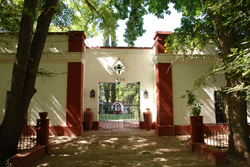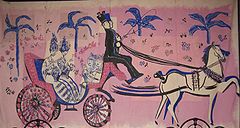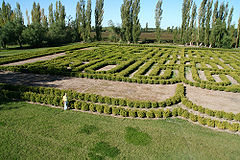
Finca Los Alamos
Encyclopedia

Estância
Estância is a municipality located in the Brazilian state of Sergipe. Its population was 62,218 and its area is 642 km². The city is the seat of the Roman Catholic Diocese of Estância....
located in San Rafael, Mendoza
San Rafael, Mendoza
San Rafael is a city in the southern region of the Mendoza Province, Argentina. With more than 170,000 inhabitants , it is the largest city and the seat of San Rafael Department....
. The estate was built in 1830 by the Bombal family, and originally served as a frontier fort. Domingo Bombal, who served eleven terms as Governor to the Mendoza Province (between 1863–1890), owned the estate until his death in 1908.
After decades of neglect, the property was revived by Argentine writer Susana Bombal in the 1930s. Susana brought touches of Buenos Aires sophistication to the newly restored property, including colonial furniture, original manuscripts and mural paintings. She was friends with a number of bohemian artists from the 1930s-60s who made the retreat to Finca Los Alamos, 140 miles (225.3 km) south of Mendoza
Mendoza, Argentina
Mendoza is the capital city of Mendoza Province, in Argentina. It is located in the northern-central part of the province, in a region of foothills and high plains, on the eastern side of the Andes. As of the , Mendoza's population was 110,993...
. Each visiting artist added special touches that remain today, making the property a museum of sorts, and truly unique. Susana, who shared a profound friendship with author and poet Jorge Luis Borges
Jorge Luis Borges
Jorge Francisco Isidoro Luis Borges Acevedo , known as Jorge Luis Borges , was an Argentine writer, essayist, poet and translator born in Buenos Aires. In 1914 his family moved to Switzerland where he attended school, receiving his baccalauréat from the Collège de Genève in 1918. The family...
, owned the property until 1992. The property features original works of art and culture from many famous Argentinean figures including Borges, Raúl Soldi
Raúl Soldi
Raúl Soldi was an Argentine painter whose work treated various subjects, including landscapes, portraits, the theater and the circus, and nature. His theatrical figures are renowned for their melancholy appearance...
, Hector Basaldua, and Manuel Mujica Láinez
Manuel Mujica Laínez
Manuel Mujica Láinez was an Argentine novelist, essayist and art critic.-Biography:...
.
The estate, which now serves as a boutique hotel, is still owned by the Bombal family, who also run the hotel.

Features

Randoll Coate
Gilbert Randoll Coate was a British diplomat, maze designer and "labyrinthologist".-Early life:The son of Charles Philip Coate, an expatriate businessman, Randoll Coate was born in Lausanne, Switzerland. After studying at the Collège de Lausanne he won a scholarship to Oriel College, Oxford,...
, a British diplomat, maze
Maze
A maze is a tour puzzle in the form of a complex branching passage through which the solver must find a route. In everyday speech, both maze and labyrinth denote a complex and confusing series of pathways, but technically the maze is distinguished from the labyrinth, as the labyrinth has a single...
designer, and "labyrinthologist". The maze pays tribute to Jorge Luis Borges
Jorge Luis Borges
Jorge Francisco Isidoro Luis Borges Acevedo , known as Jorge Luis Borges , was an Argentine writer, essayist, poet and translator born in Buenos Aires. In 1914 his family moved to Switzerland where he attended school, receiving his baccalauréat from the Collège de Genève in 1918. The family...
(also a personal friend of Coate's) and may have been inspired by Borges' short stories El Jardin de senderos que se bifurcan (The Garden of Forking Paths
The Garden of Forking Paths
"The Garden of Forking Paths" is a 1941 short story by Argentine writer and poet Jorge Luis Borges. It is the title story in the collection El jardín de senderos que se bifurcan , which was republished in its entirety in Ficciones in 1944...
), and Labyrinths. Shaped like an open book, the design spells out Borges' name as reflected in a mirror, and also pays tribute to writer Maria Kodama
María Kodama
María Kodama Schweitzer is the widow of Argentine author Jorge Luis Borges and sole owner of his estate after his death in 1986. Borges had bequeathed to Kodama his rights as author in a will written in 1979, when she was his literary secretary, and bequeathed to her his whole estate in 1985...
, Jorge's widow, by including her initials.
In literature
The estate is featured in the book Estancias, The Great Houses and Ranches of Argentina, by Maria Saenz Quesada. The book details over thirty historical Argentine properties with origins as far back as the 16th century, through their rise at the end of the 18th century (when these estates played an integral role in making Argentina one of the world's most powerful economic empires), and the significant functions of these estancias today. The book suggests that Los Alamos may be the oldest house to survive the 1861 Mendoza earthquake1861 Mendoza earthquake
The 1861 Mendoza earthquake was a major seismic movement in the province of Mendoza, Argentina. It took place on 20 March 1861, at 11:30 PM. It had a magnitude of 7.2 on the Surface wave magnitude scale and an intensity of IX in the Mercalli scale...
that devastated the Province.
Estancias, The Great Houses and Ranches of Argentina, by Maria Saenz Quesada. (Abbeville Press, Inc. 1992) ISBN 978-1-55859-270-4

